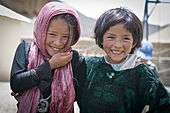Qalandar (clan)
The Qalandar (Hindi: क़लन्दर, Urdu: قلندر) are a Muslim ethnic group, found in North India and Pakistan. They are also known as Qalander Faqir. A few Qalandar are also found in the Terai region of Nepal.
History and origin
The Qalandar in India trace their origin back to the devotees of the Sufi saint Bu Ali Shah Qalandar, who is buried in Panipat, in what is now Haryana. These devotees left their homes in the cities of Karnal and Panipat for some unknown reason and settled in territory that now forms part of the modern state of Uttar Pradesh. Initially, these devotee belonged to the Sufi order of the Qalandariyah Faqirs, who then took to the profession of bear fighting. The Qalandar consists of three sub-divisions, the Langre in eastern Rohilkhand, the Rohilla in western Rohilkhand and the Machhle in Awadh, all of whom are found in Uttar Pradesh, and speak their own dialect, known as Qalandari.
In Pakistan, the Qalandar are found mainly in Pakistani Punjab. According to their traditions, the Qalandar are descended of ancestors that arrived in from Balkh and Bukhara in Central Asia in the distant past. These settlers were all said to be devotees of the Sufi saint Bu Ali Qalandar of Panipat. Unlike the Uttar Pradesh Qalandar who moved east, the Qalandar of what became Pakistan began a slow migration westward, with small groups moving into Punjab by mid 15th Century. At the time of the partition of India in 1947, the Muslim Qalandar of east Punjab, which included Panipat and Karnal moved to Pakistan, joining groups who were already settled there.

Qalandar
Qalandars (Arabic: قلندر), are wandering ascetic Sufi dervishes who may or may not be connected to a specific tariqat. They were mostly in Central Asia, India and Pakistan, in the latter "qalandar" is also used as a title. Some famous Qalandars include Lal Shahbaz Qalandar, Bu Ali Shah Qalandar and Shams Ali Qalandar.
Qalandar as honorific title
Qalander is a person who has excelled in seeing things and advances stage by stage into the Being. He even rises above the Administrative System and witnesses the core of Oneness in detail and after enjoying the Unity of the Being returns back without losing his grades and then reaches back into his humanly status, so much so that his rise and fall becomes one and the same thing for him.. He witnesses part in the whole and sees the whole in the part and, then, after detaching himself from all this, plunges into a state of ecstasy.
Status of a Qalander is even higher than the loved ones because duality remains there even in that state, i.e. one is the loved one and the other is the loving. In Qalanderiyat there is no duality.(From Book of Khwaja Shamsuddin Azeemi's Tazkira Qalandar Baba Aulia)...ksars.org

Qalandar (Hazara tribe)
The Qalandar are a tribe of Hazara found in Afghanistan. Maitland identifies the Qalandar as falling within a similar area as the Jaghori Hazaras (Ghazni Province and the upper Arghandab Valley), but "not directly affiliated" and of different origin. The Qalandar are believed to be late-19th century refugees from Day Chopan and Arjestan.
See also
References
Qalandar (disambiguation)
Qalandar may refer to:
Places in Iran
See also
Podcasts:

